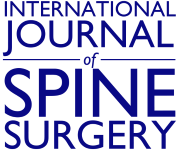Article Figures & Data
Tables
Procedure Summary Features Laminectomy Indications
● Symptomatic spinal canal stenosis that does not respond to conservative treatment
● Rapidly progressing neurological deficits or intolerable pain
● Cauda equina syndromeContraindications
● Patients with multiple medical comorbidities including depression
● Scoliosis
● Spondylolysthesis
● Lateral listhesisApproaches
● OpenAdvantages
● High success rate with significant alleviation of preoperative symptoms
● Low rate of postoperative complications that continues to reduce with the implementation of less invasive approachesDisadvantages
● Potential iatrogenic disruption of posterior structures and anatomy/biomechanics of spine
● May require concomitant fusionLaminoplasty Indications
● Symptomatic stenosis without any signs of significant instabilityContraindications
● Severe osteoporosis or active infection
● Significant instability requiring fusionApproaches
● OpenAdvantages
● Posterior spinal structures preserved
● Reduced risk of postoperative spinal instability and deformityDisadvantages
● Limited literature looking at long-term outcomes of lumbar laminoplasty compared to other procedures
● Greater risk for nerve root injury intraoperatively
● Longer operative timeLaminotomy Indications
● Spinal stenosis with neurological symptoms
● Multilevel spondylotic lateral canal stenosis
● Lateral recess stenosis secondary to disc herniationContraindications
● Severe instability necessitating fusion
● Pan-canal or central stenosis
● Severe facet joint arthritis or osteoporosisApproaches
● Open, minimally invasive, endoscopic (includes inside-out, outside-in, contralateral techniques)
● Unilateral and bilateralAdvantages
● Reduced risk for iatrogenic mechanical instability and prolonged recovery when compared to laminectomy
● Superior preservation of posterior spinal structuresDisadvantages
● Limited extent of decompression when compared to laminectomy
● May not fully alleviate central canal stenosisForaminotomy Indications
● Foraminal stenosis with compression of neural structuresContraindications
● Severe spinal instability (e.g., scoliosis, spondylolisthesis, kyphosis) necessitating fusion
● Significant neurological deficits requiring more extensive decompression
● Active infection or severe osteoporosisApproaches
● Open, minimally invasive, endoscopic (includes transforaminal and laser assisted endoscopic foraminotomies)Advantages
● Preserves lamina integrity
● Potential postoperative improvement of both foraminal diameter and heightDisadvantages
● Risk of nerve injury
● Reduced access to central canal leading to potential risk for incomplete decompression and symptom recurrencePercutaneous Minimally Invasive Lumbar Decompression (MILD) Indications
● Stenosis secondary to ligamentum flavum hypertrophy ≥2.5 mm
● Typically reserved for patients with multiple medical comorbidities making them high-risk candidates for traditional proceduresContraindications
● Previous spinal surgery
● Infection at the site of potential surgeryApproaches
● Percutaneous approach through a small incision
● Performed utilizing local anesthesia with the assistance of fluoroscopic guidanceAdvantages
● Is safe for patients with comorbidities that make it challenging to tolerate traditional spinal surgery such as laminectomy and laminotomy
● Does not require general anesthesia
● Minimally invasive, avoiding large incisions and lamina removalDisadvantages
● Limited decompression compared to traditional surgical method
● Limited evidence and literature available showing long-term efficacyProcedure Summary Features Endoscopic Microdiscectomy Indications
● Lumbar disc herniation resulting in neurological deficits and radiculopathy not responding to conservative managementContraindications
● Severe facet joint arthritis or active infection
● Severe central canal stenosis requiring extensive decompression than provided by microdiscectomyApproaches
● Interlaminar or TransforaminalAdvantages
● Reduced soft tissue and bony trauma
● Smaller incision and improved visualization of the surgical site
● Shorter LOS in hospital and faster recoveryDisadvantages
● Steep learning curve
● Potential for limited access to complex herniations or multi-level diseases increasing risk of incomplete decompressionTransforaminal Endoscopic Lumbar Foraminotomies (TELF) Indications
● Foraminal stenosis with nerve root compression
● Lateral recess stenosis caused by disc herniationContraindications
● Necessity for more extensive decompression due to severe central canal stenosis
● Severe facet joint arthritis or active infectionApproaches
● TransforaminalAdvantages
● Improved visualization of neural structures along with smaller incisions resulting in reduced soft tissue trauma
● Enhanced preservation of structures around surgical site and improved postoperative spinal stabilityDisadvantages
● Reduced access to central canal
● Challenging to achieve full decompression in severe cases of foraminal stenosisEndoscopic Unilateral Laminotomy for Bilateral Decompression (ULBD) Indications
● Symptomatic disc herniation not responding to conservative management
● Lumbar spinal stenosis resulting in bilateral neural compressionContraindications
● Severe central canal stenosis requiring more invasive approaches to achieve adequate decompression
● Significant spinal instability such as vertebral fractures or severe spondylolisthesis
● Severe facet joint arthritis or active infectionApproaches
● Typically interlaminarAdvantages
● Preservation of contralateral structures due to unilateral approach for bilateral decompression
● Smaller incisions, reduced soft tissue trauma, quicker recovery, and shorter in hospital LOSDisadvantages
● Steep learning curve
● Limited access to central canalAbbreviations: LOS, length of stay; TELF, transforaminal endoscopic lumbar foraminotomies; ULBD, unilateral laminotomy for bilateral decompression.






